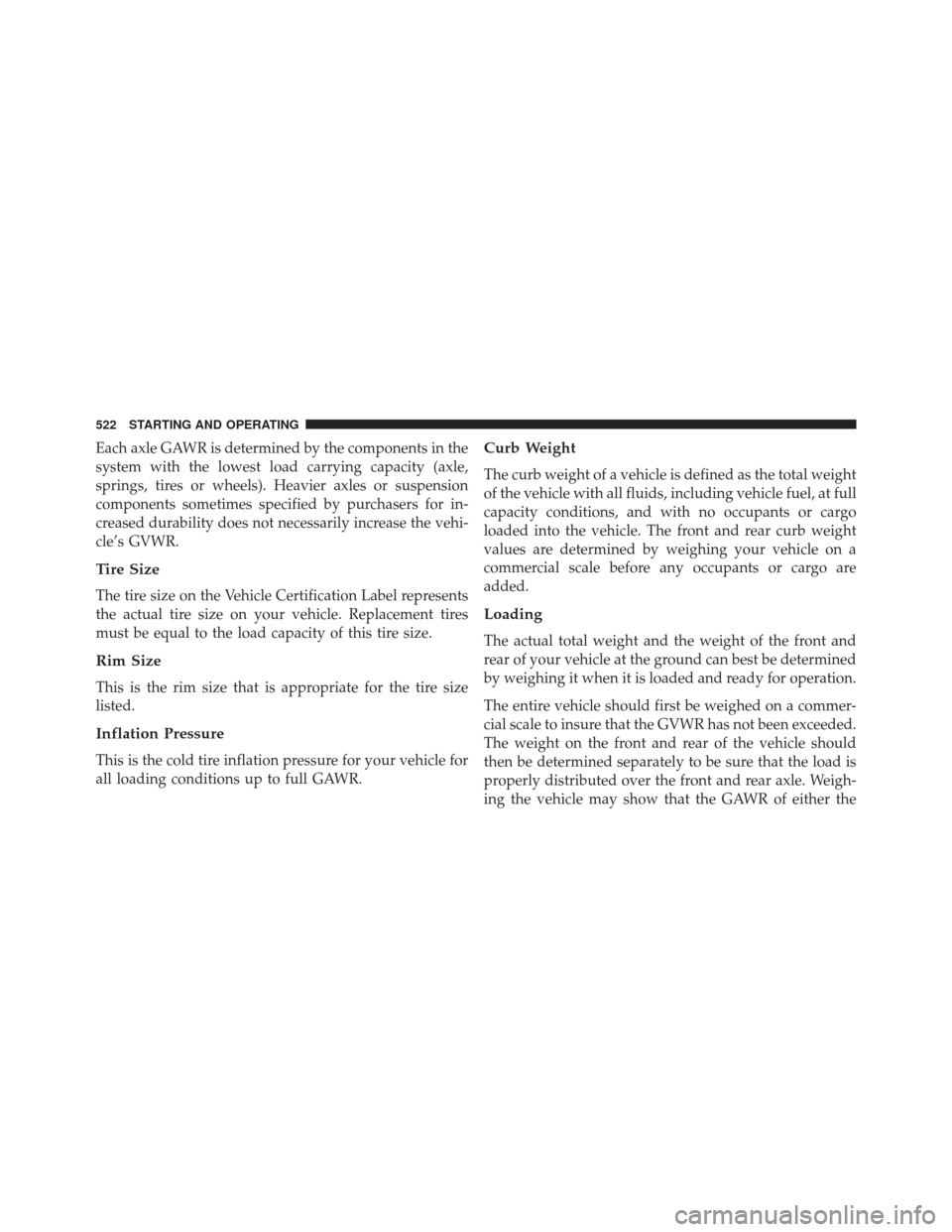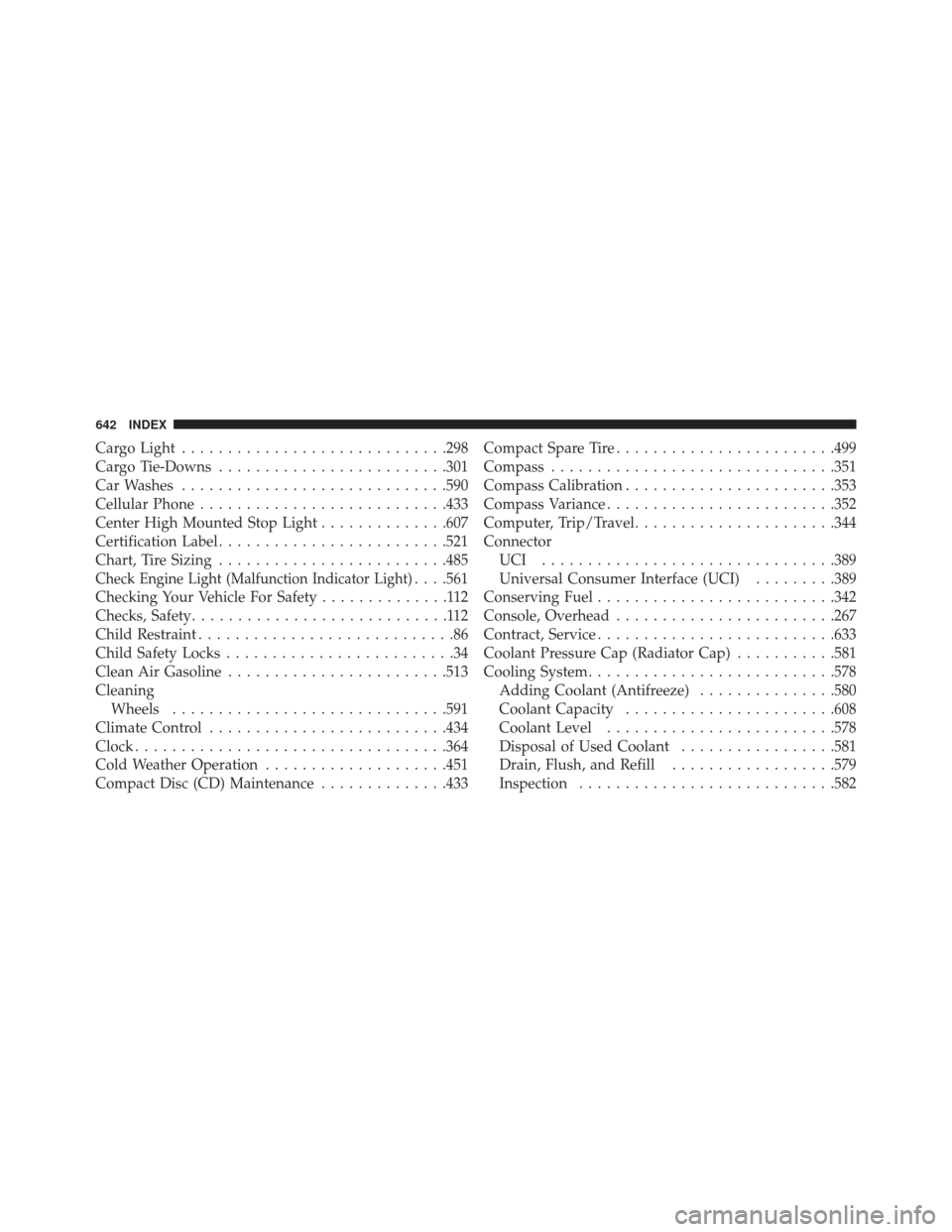Page 524 of 661

Each axle GAWR is determined by the components in the
system with the lowest load carrying capacity (axle,
springs, tires or wheels). Heavier axles or suspension
components sometimes specified by purchasers for in-
creased durability does not necessarily increase the vehi-
cle’s GVWR.
Tire Size
The tire size on the Vehicle Certification Label represents
the actual tire size on your vehicle. Replacement tires
must be equal to the load capacity of this tire size.
Rim Size
This is the rim size that is appropriate for the tire size
listed.
Inflation Pressure
This is the cold tire inflation pressure for your vehicle for
all loading conditions up to full GAWR.
Curb Weight
The curb weight of a vehicle is defined as the total weight
of the vehicle with all fluids, including vehicle fuel, at full
capacity conditions, and with no occupants or cargo
loaded into the vehicle. The front and rear curb weight
values are determined by weighing your vehicle on a
commercial scale before any occupants or cargo are
added.
Loading
The actual total weight and the weight of the front and
rear of your vehicle at the ground can best be determined
by weighing it when it is loaded and ready for operation.
The entire vehicle should first be weighed on a commer-
cial scale to insure that the GVWR has not been exceeded.
The weight on the front and rear of the vehicle should
then be determined separately to be sure that the load is
properly distributed over the front and rear axle. Weigh-
ing the vehicle may show that the GAWR of either the
522 STARTING AND OPERATING
Page 559 of 661
MAINTAINING YOUR VEHICLE
CONTENTS
�ENGINE COMPARTMENT — 6.4L ..........559
� ONBOARD DIAGNOSTIC SYSTEM (OBD II) . . .560
▫ Loose Fuel Filler Cap Message ............560
� EMISSIONS INSPECTION AND
MAINTENANCE PROGRAMS .............561
� REPLACEMENT PARTS ..................562
� DEALER SERVICE ..................... .562
� MAINTENANCE PROCEDURES ...........563
▫ Engine Oil ......................... .564
▫ Engine Oil Filter ..................... .567▫
Engine Air Cleaner Filter ................567
▫ Maintenance-Free Battery ...............568
▫ Air Conditioner Maintenance .............569
▫ Body Lubrication .....................572
▫ Windshield Wiper Blades ...............572
▫ Adding Washer Fluid ..................574
▫ Exhaust System ..................... .575
▫ Cooling System ..................... .578
▫ Brake System ....................... .583
▫ Front/Rear Axle Fluid ..................585
7
Page 562 of 661

ONBOARD DIAGNOSTIC SYSTEM (OBD II)
Your vehicle is equipped with a sophisticated onboard
diagnostic system called OBD II. This system monitors
the performance of the emissions, engine, and automatic
transmission control systems. When these systems are
operating properly, your vehicle will provide excellent
performance and fuel economy, as well as engine emis-
sions well within current government regulations.
If any of these systems require service, the OBD II system
will turn on the “Malfunction Indicator Light (MIL).” It
will also store diagnostic codes and other information to
assist your service technician in making repairs. Al-
though your vehicle will usually be drivable and not
need towing, see your authorized dealer for service as
soon as possible.
CAUTION!
•Prolonged driving with the MIL on could cause
further damage to the emission control system. It
could also affect fuel economy and drivability. The
vehicle must be serviced before any emissions tests
can be performed.
• If the MIL is flashing, while the engine is running,
severe catalytic converter damage and power loss
will soon occur. Immediate service is required.
Loose Fuel Filler Cap Message
If the vehicle diagnostic system determines
that the fuel filler cap is loose, improperly
installed, or damaged, a loose gascap indicator
will display in the EVIC telltale display area.
Refer to “Electronic Vehicle Information Center (EVIC) in
560 MAINTAINING YOUR VEHICLE
Page 563 of 661

“Understanding Your Instrument Panel” for further in-
formation. Tighten the fuel filler cap properly and press
the SELECT button to turn off the message. If the
problem continues, the message will appear the next time
the vehicle is started.
A loose, improperly installed, or damaged fuel filler cap
may also turn on the Malfunction Indicator Light (MIL).
EMISSIONS INSPECTION AND MAINTENANCE
PROGRAMS
In some localities, it may be a legal requirement to pass
an inspection of your vehicle’s emissions control system.
Failure to pass could prevent vehicle registration.For states that require an Inspection and Mainte-
nance (I/M), this check verifies the “Malfunction
Indicator Light (MIL)” is functioning and is not
on when the engine is running, and that the OBD II
system is ready for testing. Normally, the OBD II system will be ready. The OBD II
system may
notbe ready if your vehicle was recently
serviced, recently had a dead battery or a battery replace-
ment. If the OBD II system should be determined not
ready for the I/M test, your vehicle may fail the test.
Your vehicle has a simple ignition key-actuated test,
which you can use prior to going to the test station. To
check if your vehicle’s OBD II system is ready, you must
do the following:
1. Turn the ignition switch to the ON position, but do not crank or start the engine.
2. If you crank or start the engine, you will have to start this test over.
3. As soon as you turn the ignition switch to the ON position, you will see the MIL symbol come on as part
of a normal bulb check.
7
MAINTAINING YOUR VEHICLE 561
Page 610 of 661
FLUID CAPACITIES
U.S.Metric
Fuel (Approximate) 25 Gallons94 Liters
Engine Oil With Filter
6.4 Liter Engine (SAE 0W-40, Synthetic API Certified) 7 Quarts6.6 Liters
Cooling System*
6.4 Liter Engine (MOPAR� Antifreeze/Engine Coolant 10 Year/
150,000 Mile Formula or equivalent) 16 Quarts
15.5 Liters
* Includes heater and coolant recovery bottle filled to MAX level.
608 MAINTAINING YOUR VEHICLE
Page 643 of 661

Fluid Type.......................... .587
Special Additives ...................... .588
Autostick .............................. .463
Auxiliary Electrical Outlet (Power Outlet) ........286
Auxiliary Power Outlet .....................286
Battery ................................ .568
Keyless Transmitter Replacement (RKE) ........25
Belts, Seat ...............................54
Blind Spot Monitoring ..................... .129
Body Mechanism Lubrication .................572
B-Pillar Location ......................... .489
Brake Assist System ...................... .475
Brake Control System, Electronic ..............473
Brake Fluid ............................ .584
Brake System ........................... .583
Anti-Lock (ABS) ...................... .474
Fluid Check .......................... .584
Master Cylinder ....................... .584Parking
............................. .471
Warning Light ........................ .321
Brake/Transmission Interlock .................455
Break-In Recommendations, New Vehicle ........111
Bulb Replacement ........................ .602
Bulbs, Light .............................116
Calibration, Compass ..................... .353
Camera, Rear ........................... .264
Capacities, Fluid ......................... .608
Caps, Filler Fuel ............................... .517
Oil (Engine) ......................... .566
Radiator (Coolant Pressure) ...............581
Carbon Monoxide Warning ..................113
Cargo Area Cover ........................ .300
Cargo Area Features ...................... .297
Cargo Compartment ...................... .297
Light .............................. .298
10
INDEX 641
Page 644 of 661

Cargo Light............................ .298
Cargo Tie-Downs ........................ .301
Car Washes ............................ .590
Cellular Phone .......................... .433
Center High Mounted Stop Light ..............607
Certification Label ........................ .521
Chart, Tire Sizing ........................ .485
Check Engine Light (Malfunction Indicator Light). . . .561
Checking Your Vehicle For Safety ..............112
Checks, Safety ............................112
Child Restraint ............................86
Child Safety Locks .........................34
Clean Air Gasoline ....................... .513
Cleaning Wheels ............................. .591
Climate Control ......................... .434
Clock ................................. .364
Cold Weather Operation ....................451
Compact Disc (CD) Maintenance ..............433Compact Spare Tire
....................... .499
Compass .............................. .351
Compass Calibration ...................... .353
Compass Variance ........................ .352
Computer, Trip/Travel ..................... .344
Connector UCI ............................... .389
Universal Consumer Interface (UCI) .........389
Conserving Fuel ......................... .342
Console, Overhead ....................... .267
Contract, Service ......................... .633
Coolant Pressure Cap (Radiator Cap) ...........581
Cooling System .......................... .578
Adding Coolant (Antifreeze) ...............580
Coolant Capacity ...................... .608
Coolant Level ........................ .578
Disposal of Used Coolant .................581
Drain, Flush, and Refill ..................579
Inspection ........................... .582
642 INDEX
Page 645 of 661

Points to Remember.....................582
Pressure Cap ......................... .581
Radiator Cap ......................... .581
Selection of Coolant (Antifreeze) ............579
Corrosion Protection ...................... .589
Cruise Control (Speed Control) ................225
Cupholders ............................ .293
Customer Assistance ...................... .631
Data Recorder, Event .......................84
Daytime Running Lights ....................204
Dealer Service ........................... .562
Defroster, Rear Window .....................304
Defroster, Windshield ......................114
Disabled Vehicle Towing ....................555
Disposal Antifreeze (Engine Coolant) ...............581
Door Locks ..............................32
Door Locks, Automatic ......................34 Door Opener, Garage
...................... .269
Driving Through Flowing, Rising, or Shallow
Standing Water ....................... .467
Driving to Achieve Maximum Fuel Economy ......342
Electrical Outlet, Auxiliary (Power Outlet) ........286
Electric Rear Window Defrost .................304
Electric Remote Mirrors .....................127
Electronic Brake Control System ...............473
Brake Assist System .....................475
Electronic Roll Mitigation (ERM) ..............475
Electronic Speed Control (Cruise Control) ........221
Electronic Stability Control (ESC) ..............476
Electronic Vehicle Information Center (EVIC) ......318
Emergency, In Case of Freeing Vehicle When Stuck ...............552
Hazard Warning Flasher ..................536
Jump Starting ........................ .548
10
INDEX 643